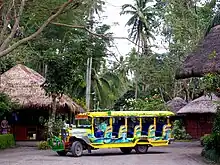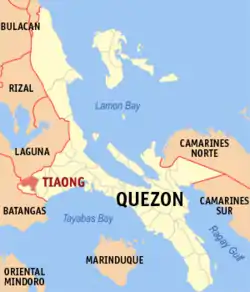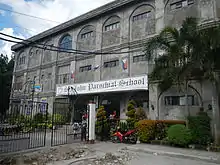Tiaong | |
|---|---|
| Municipality of Tiaong | |
     From top, left to right: Quezon-Laguna Boundary Arch, Saint John the Baptist Parish Church, Municipal Hall, Claro M. Recto Memorial Shrine, Villa Escudero | |
 Flag  Seal | |
Nicknames:
| |
 Map of Quezon with Tiaong highlighted | |
OpenStreetMap | |
.svg.png.webp) Tiaong Location within the Philippines | |
| Coordinates: 13°57′N 121°19′E / 13.95°N 121.32°E | |
| Country | Philippines |
| Region | Calabarzon |
| Province | Quezon |
| District | 2nd district |
| Founded | May 12, 1691 |
| Barangays | 31 (see Barangays) |
| Government | |
| • Type | Sangguniang Bayan |
| • Mayor | Vincent Arjay M. Mea |
| • Vice Mayor | Roderick A. Umali |
| • Representative | David C. Suarez |
| • Municipal Council | Members |
| • Electorate | 64,797 voters (2022) |
| Area | |
| • Total | 168.38 km2 (65.01 sq mi) |
| Elevation | 94 m (308 ft) |
| Highest elevation | 849 m (2,785 ft) |
| Lowest elevation | 11 m (36 ft) |
| Population (2020 census)[3] | |
| • Total | 106,265 |
| • Density | 630/km2 (1,600/sq mi) |
| • Households | 26,509 |
| Demonym | Tiaongin |
| Economy | |
| • Income class | 1st municipal income class |
| • Poverty incidence | 6.78 |
| • Revenue | ₱ 312.2 million (2020) |
| • Assets | ₱ 1,265 million (2020) |
| • Expenditure | ₱ 221.9 million (2020) |
| • Liabilities | ₱ 495.4 million (2020) |
| Service provider | |
| • Electricity | Manila Electric Company (Meralco) |
| Time zone | UTC+8 (PST) |
| ZIP code | 4325 |
| PSGC | |
| IDD : area code | +63 (0)42 |
| Native languages | Tagalog |
| Website | tiaongquezon |
Tiaong ([ˈtjaɔŋ]), officially the Municipality of Tiaong (Tagalog: Bayan ng Tiaong), is a 1st class municipality in the province of Quezon, Philippines. According to the 2020 census, it has a population of 106,265 people.[3]
Tiaong is 35 kilometers (22 mi) from Lucena and 95 kilometers (59 mi) from Manila.
Etymology
According to local legends, Tiaong derived its name from the portmanteau of two words:
History
In 1957, the following barrios were created:
Geography
Barangays
Tiaong is politically subdivided into 31 barangays. Each barangay consists of puroks and some have sitios.
- Anastacia
- Aquino
- Ayusan I
- Ayusan II
- Behia
- Bukal
- Bula
- Bulakin
- Cabatang
- Cabay
- Del Rosario
- Lagalag
- Lalig
- Lumingon
- Lusacan
- Paiisa
- Palagaran
- Poblacion I
- Poblacion II
- Poblacion III
- Poblacion IV
- Quipot
- San Agustin
- San Isidro
- San Jose
- San Juan
- San Pedro
- Tagbakin
- Talisay
- Tamisian
- San Francisco
Climate
| Climate data for Tiaong, Quezon | |||||||||||||
|---|---|---|---|---|---|---|---|---|---|---|---|---|---|
| Month | Jan | Feb | Mar | Apr | May | Jun | Jul | Aug | Sep | Oct | Nov | Dec | Year |
| Mean daily maximum °C (°F) | 27 (81) |
28 (82) |
30 (86) |
32 (90) |
31 (88) |
30 (86) |
29 (84) |
29 (84) |
29 (84) |
29 (84) |
28 (82) |
27 (81) |
29 (84) |
| Mean daily minimum °C (°F) | 20 (68) |
20 (68) |
21 (70) |
22 (72) |
24 (75) |
24 (75) |
24 (75) |
24 (75) |
24 (75) |
23 (73) |
22 (72) |
21 (70) |
22 (72) |
| Average precipitation mm (inches) | 52 (2.0) |
35 (1.4) |
27 (1.1) |
27 (1.1) |
82 (3.2) |
124 (4.9) |
163 (6.4) |
144 (5.7) |
145 (5.7) |
141 (5.6) |
100 (3.9) |
102 (4.0) |
1,142 (45) |
| Average rainy days | 12.0 | 8.1 | 8.8 | 9.7 | 17.9 | 22.6 | 26.2 | 24.5 | 24.6 | 22.0 | 16.7 | 14.9 | 208 |
| Source: Meteoblue[9] | |||||||||||||
Demographics
| Year | Pop. | ±% p.a. |
|---|---|---|
| 1903 | 9,527 | — |
| 1918 | 14,211 | +2.70% |
| 1939 | 27,179 | +3.14% |
| 1948 | 26,454 | −0.30% |
| 1960 | 26,084 | −0.12% |
| 1970 | 38,725 | +4.03% |
| 1975 | 43,245 | +2.24% |
| 1980 | 48,606 | +2.36% |
| 1990 | 60,662 | +2.24% |
| 1995 | 67,403 | +1.99% |
| 2000 | 75,498 | +2.46% |
| 2007 | 87,707 | +2.09% |
| 2010 | 91,599 | +1.59% |
| 2015 | 99,712 | +1.63% |
| 2020 | 106,265 | +1.26% |
| Source: Philippine Statistics Authority[10][11][12][13] | ||
Economy
Government

Town hall
Elected officials
| Position | Name of official |
|---|---|
| District Representative (2nd Legislative District, Quezon) | Rep. David C. Suarez |
| Municipal Mayor | Vincent Arjay M. Mea |
| Municipal Vice Mayor | Roderick A. Umali |
| Municipal Councilors | Ma. Maja Alexandra E. Landicho |
| Romano P. Castillo Jr. | |
| Eugene P. Lopez | |
| Elton Rex B. Baldeo | |
| Rex D. Bautista | |
| Jessa L. Preza | |
| Jonas Bryson R. Atienza | |
| Tomas P. Ilao | |
Tourism
Education

Tiaong Elementary School

Saint John Parochial School
Elementary schools
- Private school
- Southside Integrated School
- Kiddie Corner School Inc.
- Saint John Parochial School
- Gaudete Study Center Inc.
- Tiaong Christian Academy
- Maranatha Christian Academy
- Public School
- Anastacia Elementary School
- Lusacan Elementary School
- Del Rosario Elementary School
- Lagalag Elementary School
- Hilirang Buli Elementary School
- Tiaong East Elementary School
- Claro M. Recto Memorial Central School
High schools
- Private School
- St. John Parochial School
- Don Ysidro Memorial School
- Gaudete Study Center Inc.
- Public High School
- Recto Memorial National High School
- Lalig National High School
- Lusacan National High School
- Cabay National High School
- Gloria Umali National High School
- Paiisa National High School
- Talisay National High School
Colleges and universities
- Public Schools
- College
- Southern Luzon State University
- Private Schools:
- Asian Institute of Technology and Education
- Olinsterg College
Gallery

 Saint John the Baptist Parish Church of Tiaong
Saint John the Baptist Parish Church of Tiaong Moises Amat Escueta Ala-ala Park
Moises Amat Escueta Ala-ala Park Tiaong Lying-In Hospital
Tiaong Lying-In Hospital Type 89 I-Go tank at Villa Escudero, Tiaong, Quezon Province
Type 89 I-Go tank at Villa Escudero, Tiaong, Quezon Province
References
- ↑ Municipality of Tiaong | (DILG)
- ↑ "2015 Census of Population, Report No. 3 – Population, Land Area, and Population Density" (PDF). Philippine Statistics Authority. Quezon City, Philippines. August 2016. ISSN 0117-1453. Archived (PDF) from the original on May 25, 2021. Retrieved July 16, 2021.
- 1 2 Census of Population (2020). "Region IV-A (Calabarzon)". Total Population by Province, City, Municipality and Barangay. Philippine Statistics Authority. Retrieved 8 July 2021.
- ↑ "PSA Releases the 2018 Municipal and City Level Poverty Estimates". Philippine Statistics Authority. 15 December 2021. Retrieved 22 January 2022.
- ↑ Tayao, Annelle S. (March 10, 2012). "Tiaong has its come-ons". INQUIRER.net. Retrieved August 15, 2023.
- ↑ Republic Act No. 1765 (21 June 1957), An Act Creating the Barrio of Matipunso in the Municipality of Tiaong, Province of Quezon, retrieved August 15, 2023
- ↑ Republic Act No. 1766 (21 June 1957), An Act Creating the Barrio of Behia in the Municipality of Tiaong, Province of Quezon
- ↑ Republic Act No. 1767 (21 June 1957), An Act Creating the Barrio of Bucal in the Municipality of Tiaong, Province of Quezon, retrieved August 15, 2023
- ↑ "Tiaong: Average Temperatures and Rainfall". Meteoblue. Retrieved 27 January 2020.
- ↑ Census of Population (2015). "Region IV-A (Calabarzon)". Total Population by Province, City, Municipality and Barangay. Philippine Statistics Authority. Retrieved 20 June 2016.
- ↑ Census of Population and Housing (2010). "Region IV-A (Calabarzon)" (PDF). Total Population by Province, City, Municipality and Barangay. National Statistics Office. Retrieved 29 June 2016.
- ↑ Censuses of Population (1903–2007). "Region IV-A (Calabarzon)". Table 1. Population Enumerated in Various Censuses by Province/Highly Urbanized City: 1903 to 2007. National Statistics Office.
{{cite encyclopedia}}: CS1 maint: numeric names: authors list (link) - ↑ "Province of Quezon". Municipality Population Data. Local Water Utilities Administration Research Division. Retrieved 17 December 2016.
- ↑ "Poverty incidence (PI):". Philippine Statistics Authority. Retrieved December 28, 2020.
- ↑ "Estimation of Local Poverty in the Philippines" (PDF). Philippine Statistics Authority. 29 November 2005.
- ↑ "2003 City and Municipal Level Poverty Estimates" (PDF). Philippine Statistics Authority. 23 March 2009.
- ↑ "City and Municipal Level Poverty Estimates; 2006 and 2009" (PDF). Philippine Statistics Authority. 3 August 2012.
- ↑ "2012 Municipal and City Level Poverty Estimates" (PDF). Philippine Statistics Authority. 31 May 2016.
- ↑ "Municipal and City Level Small Area Poverty Estimates; 2009, 2012 and 2015". Philippine Statistics Authority. 10 July 2019.
- ↑ "PSA Releases the 2018 Municipal and City Level Poverty Estimates". Philippine Statistics Authority. 15 December 2021. Retrieved 22 January 2022.
External links
Wikimedia Commons has media related to Tiaong.
This article is issued from Wikipedia. The text is licensed under Creative Commons - Attribution - Sharealike. Additional terms may apply for the media files.